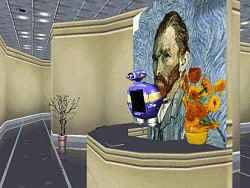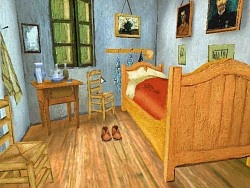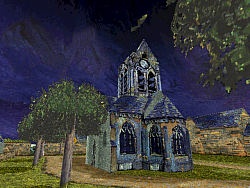|
Mission Sunlight
 This
is an arty little number, aimed at an age group of 8 to 13 and emphasising the edutainment aspect of the
life and work of the painter Vincent van Gogh. It's a gentle and colourful affair, if a little one
dimensional. This
is an arty little number, aimed at an age group of 8 to 13 and emphasising the edutainment aspect of the
life and work of the painter Vincent van Gogh. It's a gentle and colourful affair, if a little one
dimensional.
Liking or not liking a painting can be a simple thing, but it can also be a many layered experience.
Why does the subject matter look the way it does, what was going on in the artists head, and who or what
influenced the style? One piece might simply be a haystack, but see a few studies of the same haystack
at different times of day and it becomes a study in light and shade. A printed reproduction can by pretty,
but flat and somewhat lifeless; the oil original can be lumpy and detailed and alive. And a series of
works across a painter's life can encapsulate that life better than any book or film.
This latter aspect is vividly apparent in the works collected by the Rijksmuseum Vincent van Gogh in
Amsterdam. I have been lucky enough to visit and it's a remarkable collection. That collection provides
many of the works used in Mission Sunlight, and whilst it's a much lesser beast, it does a pretty
good job of giving a sense of the life of a much revered artist.
Nothing that takes about 4 or 5 hours to complete could do more than dip into that life, and Mission
Sunlight attempts to do more than that in any event. It talks of colours and what they convey, perspective
and how it was used (and ignored) by van Gogh, and why he painted potatoes and not gilt vases. It's a
snapshot and a primer to art and an artist, and not a bad one.
You start in a gallery with a robotic creature telling you that the sun has been lost and the colour therefore
taken from van Gogh's paintings. You need to put things right. As far as an overt story goes, that is the
extent of it.
 You
restore colours to the paintings by visiting the rooms in the gallery and completing tasks within the
paintings themselves. This is the first little delight of the game. You "enter" the painting and get to move
around within the 3D world it contains. More than that, each room in the gallery contains only paintings from
a particular place and time, and in Arles and Auvers-Sur-Oise, the paintings chosen "fit" together to create
the place itself (i.e., the village of Arles). It isn't seamless, but it works well enough. You
restore colours to the paintings by visiting the rooms in the gallery and completing tasks within the
paintings themselves. This is the first little delight of the game. You "enter" the painting and get to move
around within the 3D world it contains. More than that, each room in the gallery contains only paintings from
a particular place and time, and in Arles and Auvers-Sur-Oise, the paintings chosen "fit" together to create
the place itself (i.e., the village of Arles). It isn't seamless, but it works well enough.
Walking in and through the paintings was a highlight. It has been done before
(Monet for example), but it's always a buzz. Many of his well known
works are utilised, and whilst the people have been removed (a tad strange) they are faithfully reproduced.
They are also somewhat dynamic; a train goes past in Arles, rain washes The Yellow House clean, and you can
lower the Langlois Bridge (and then niftily explore the other side).
Having entered the painting, there are two objectives. One is to locate various objects, the other is to
find the links to what are called "studios", where you utilise the objects to complete each studio. A successful
competion results in a sunflower which you place in a vase. Once you have obtained enough, you can move on to
another room in the gallery. There are 3 rooms in all and about 25 sunflowers to collect.
In keeping with the age group aimed at, the tasks aren't hard. Objects you can collect will be indicated by an
active icon when the mouse is moved over it. Also, in each studio the outline of each object required to complete
the studio is shown. So its essentially a treasure hunt for the shapes.
This gets a little tedious, as there would be 30 to 40 objects in all, and it’s the only real challenge in
the game. It is made a little harder, but also potentially a little more frustrating, by the fact that some
objects are either not visible within the game world, or not able to be gathered until you have achieved
something else. A billiard ball for example cannot be picked up until you do something else, and the links
for certain studios cannot be "seen" until you have visited somewhere else. As you don't know this, and as
there is no indication that the game world works in this way, it could cause frustration for the younger
players. However given the general ease of the game, it is likely that many players will not even be aware
of this aspect, and will complete the necessary triggers without realising.
 Indeed,
the game rules could do with a little further explanation. You get the colour back into a painting
by completing the studios within the painting, but it doesn't mean you have found all the objects within that
painting. Given that getting back the colour is what you are trying to achieve, it suggests a completion, but
it's a completion of sorts. Again, taking into account the target audience, I thought that could have been
better explained. Indeed,
the game rules could do with a little further explanation. You get the colour back into a painting
by completing the studios within the painting, but it doesn't mean you have found all the objects within that
painting. Given that getting back the colour is what you are trying to achieve, it suggests a completion, but
it's a completion of sorts. Again, taking into account the target audience, I thought that could have been
better explained.
If you do get stuck though, there is a nice little hint book included with clues as to where to find the
things you need.
Each time you place a required object into a studio, you get some information about an aspect of the painting in
that studio. It could be Vincent himself telling you that he likes painting portraits but people think his
paintings are ugly and don't want to pose for him. It could be an explanation of why the walls of his room
are are painted blue and the impression that conveys, complete with animations and accompanying explanations
as to the difference if the walls were painted yellow or red. Or it could be an exposition of the lack of
perspective in a painting, with an animation showing how the painting would look if true perspective was
applied.
I thought these things were extremely well done. They were simple and clear, and articulate and illustrative.
You couldn't help but learn a little, and I will look at several of van Gogh's works differently as a result.
It is also where Vincent's life seeps through, and his story is the real one in this game. Nor is it simply a
frothy exposé of colourful paintings; the sorrow in his life is evident.
There are some little challenges within the studios themselves. You might have to reassemble a painting, or
place charcaters in their correct place. They are all quite easy, and whilst they don’t really add anything to
the learning, they do provide some different things to do.
 The
studios also allow you to examine the paintings in close up, which reveals the textures of the pieces, and
you can find out where the painting is currently held and a few other things including its actual size (well
conveyed by having a figure "hold" the painting). The
studios also allow you to examine the paintings in close up, which reveals the textures of the pieces, and
you can find out where the painting is currently held and a few other things including its actual size (well
conveyed by having a figure "hold" the painting).
You use the arrow keys to move in the game world, as well as look up and down, and the mouse to manipulate
objects. Get too close too an object and its pixels are apparent, but the graphics are generally well done. It's
a colourful game as you would expect. Hit the mouse key for the menu, where you can fiddle with a few things,
and also revisit any completed part of the game, or replay any of the completed sequences. Clicking on a utilised
object in a studio will also repeat the information provided when that object was first placed. The game saves
automatically, and returns you to where you were up to. It can manage this for more than one player at a time.
Best seen as an edutainment outing, its hard not to like Mission Sunlight. What it does it does well,
and whilst it is a game primarily for the age group specified, I think it successfully adds a layer (or three)
to his work even outside that target audience.
Copyright © Steve Ramsey 2008.
All rights reserved.
System Requirements:
Pentium 133 processor, Windows 95, 16MB RAM, 2MB Video RAM, 4 X CD-ROM, 16-bit sound card, 256 colours
|

